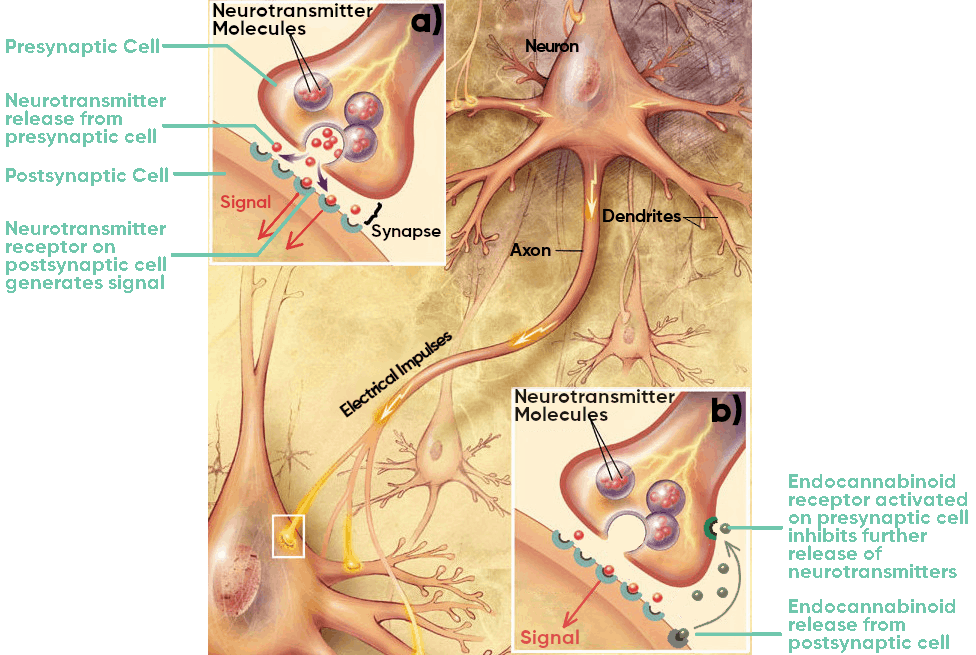Retrograde Messaging
Endocannabinoids are described as retrograde transmitters because they commonly travel backwards against the usual synaptic {call-out, text:Space between two neurons where messaging takes place.} neurotransmitter {call-out, text:Messenger compounds that travel through the small space between two neurons called synaptic cleft.} flow. This means that they are released from the postsynaptic cell and act on the presynaptic cell, where the target receptors are located. This reverse, i.e. retrograde messaging indicates that the postsynaptic cell wants to communicate to the presynaptic cell to take action or stop taking action and is representative for a system that wants to keep
homeostasis, i.e. a physiological balance in the body.
 Figure 1: Retrograde signaling – The endocannabinoids anandamide and 2-arachidonoylglycerol are released from post-synaptic neurons. Once they are released, the endocannabinoids (green balls) migrate to the presynaptic neuron, where they bind to the cannabinoid receptor-1 (CB1). When the CB1 receptor is activated, a cascade happens inside the neuron that results in a decrease in the release of neurotransmitters or messenger molecules, such as
Figure 1: Retrograde signaling – The endocannabinoids anandamide and 2-arachidonoylglycerol are released from post-synaptic neurons. Once they are released, the endocannabinoids (green balls) migrate to the presynaptic neuron, where they bind to the cannabinoid receptor-1 (CB1). When the CB1 receptor is activated, a cascade happens inside the neuron that results in a decrease in the release of neurotransmitters or messenger molecules, such as GABA and glutamate
. By modulating neurotransmitter release, the endocannabinoid system can regulate homeostasis, or physiological balance in the body (image taken from Wikipedia; edited by Cannify).
 Figure 1: Retrograde signaling – The endocannabinoids anandamide and 2-arachidonoylglycerol are released from post-synaptic neurons. Once they are released, the endocannabinoids (green balls) migrate to the presynaptic neuron, where they bind to the cannabinoid receptor-1 (CB1). When the CB1 receptor is activated, a cascade happens inside the neuron that results in a decrease in the release of neurotransmitters or messenger molecules, such as GABA and glutamate. By modulating neurotransmitter release, the endocannabinoid system can regulate homeostasis, or physiological balance in the body (image taken from Wikipedia; edited by Cannify).
Figure 1: Retrograde signaling – The endocannabinoids anandamide and 2-arachidonoylglycerol are released from post-synaptic neurons. Once they are released, the endocannabinoids (green balls) migrate to the presynaptic neuron, where they bind to the cannabinoid receptor-1 (CB1). When the CB1 receptor is activated, a cascade happens inside the neuron that results in a decrease in the release of neurotransmitters or messenger molecules, such as GABA and glutamate. By modulating neurotransmitter release, the endocannabinoid system can regulate homeostasis, or physiological balance in the body (image taken from Wikipedia; edited by Cannify).
_logo.svg)